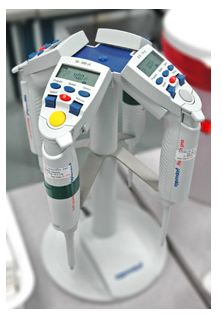Archival Notice
This is an archive page that is no longer being updated. It may contain outdated information and links may no longer function as originally intended.
Home | Glossary | Resources | Help | Contact Us | Course Map
Pipettes are used as a tool for transferring fluids. Many new analysts are familiar with glass and/or plastic volumetric and Mohr pipette that are commonly used in college laboratories. Many new analysts are not as familiar with the micropipettes used in forensic laboratories. Generally, forensic laboratories do not use glass and/or plastic pipettes in forensic DNA analysis, so these will not be covered. It should be noted that proper pipette calibration is essential. Pipette calibration can be done by laboratory staff or through an outside vendor. It is important to ensure the reference standards used be traceable to the National Institute of Standards and Technology (NIST).
Single Channel Pipettes (fixed or adjustable)
Single Channel Pipettes are those which dispense fluids via one channel. These can come in a fixed volume (only one volume can be dispersed from the pipette) or an adjustable volume (more than one volume can be dispersed based on the pipette settings). Most single channel pipettes have built in tip ejectors so that the analyst need not remove the tips by hand, and utilize an air-displacement mechanism for volume measurement.
Multi-Channel Pipettes (fixed or adjustable)
Multi-channel pipettes are those which dispense fluid via more than one channel utilizing an air-displacement mechanism. Most multi-channel pipettes are adjustable volume and have built in tip ejectors. Multi-channel pipettes can be obtained in 8 channel varieties, which make them quite useful in setting up multi-welled plates used in thermal cyclers and genetic analyzers.
Motorized/Electronic Pipettes (fixed or adjustable)
Motorized/electronic single and multi-channel pipettes are available. These pipettes have electronic operation from aspiration to tip ejection. Pipette use can contribute to Repetitive Strain Injuries (RSI), and many users find that tip ejection and pipette operation are significant contributing factors. Motorized/electronic pipettes negate the issues by allowing these processes to be accomplished by touching a button. Volume adjustments are generally made with a stepping motor to control piston action, which are usually controlled by a microprocessor.
Positive Displacement Pipettes
Positive displacement pipettes are generally used for difficult liquids. Air displacement pipettes reach their limits with high density, viscosity, and vapor pressure liquids. Positive displacement pipettes work by having a piston-integrated tip. The piston makes contact with the liquid, and a positive wiping action of the piston against the capillary walls of the tip assures dispensing without residual droplets. Positive displacement pipettes can come in fixed and adjustable, single or multi-channel varieties.
Repeat Pipettes (fixed or adjustable)
Repeat pipettes are those which allow for multiple dispensings from a single aspiration. These are quite useful when the same volume of a reagent must be place into multiple tubes or wells. These can come in fixed and adjustable volumes, single and multi-channel, and air-dispersing and positive displacement varieties.
Additional Online Courses
- What Every First Responding Officer Should Know About DNA Evidence
- Collecting DNA Evidence at Property Crime Scenes
- DNA – A Prosecutor’s Practice Notebook
- Crime Scene and DNA Basics
- Laboratory Safety Programs
- DNA Amplification
- Population Genetics and Statistics
- Non-STR DNA Markers: SNPs, Y-STRs, LCN and mtDNA
- Firearms Examiner Training
- Forensic DNA Education for Law Enforcement Decisionmakers
- What Every Investigator and Evidence Technician Should Know About DNA Evidence
- Principles of Forensic DNA for Officers of the Court
- Law 101: Legal Guide for the Forensic Expert
- Laboratory Orientation and Testing of Body Fluids and Tissues
- DNA Extraction and Quantitation
- STR Data Analysis and Interpretation
- Communication Skills, Report Writing, and Courtroom Testimony
- Español for Law Enforcement
- Amplified DNA Product Separation for Forensic Analysts


